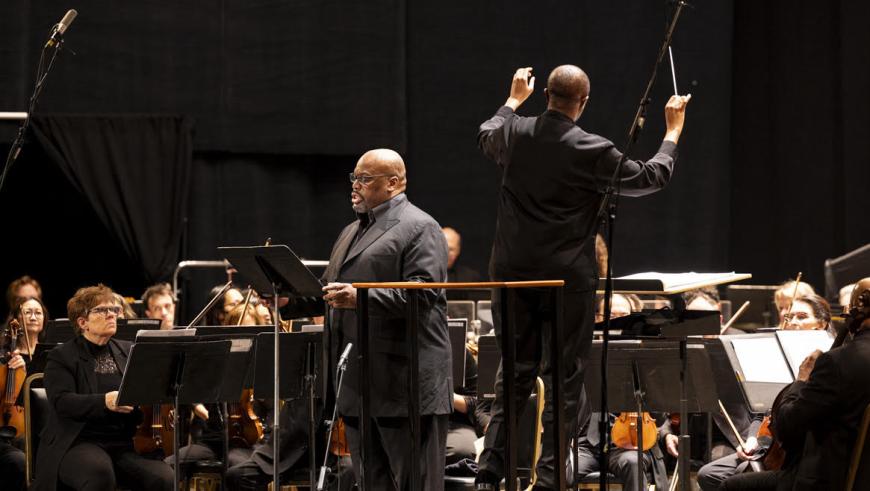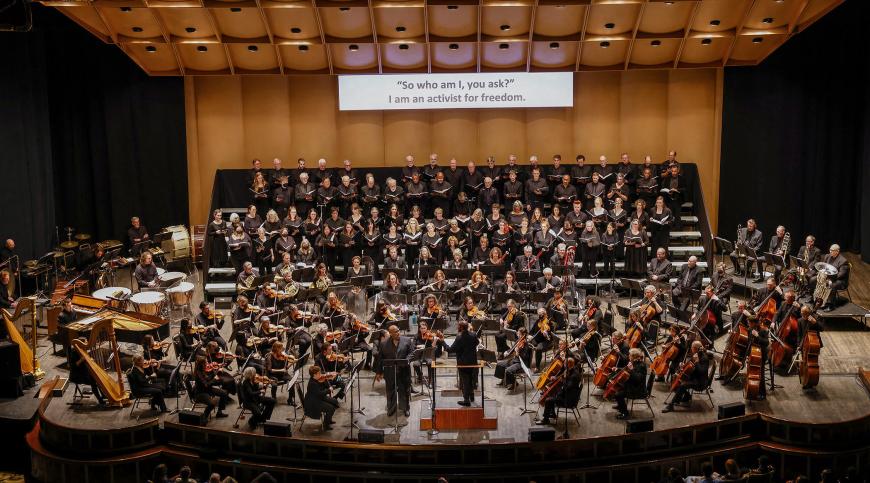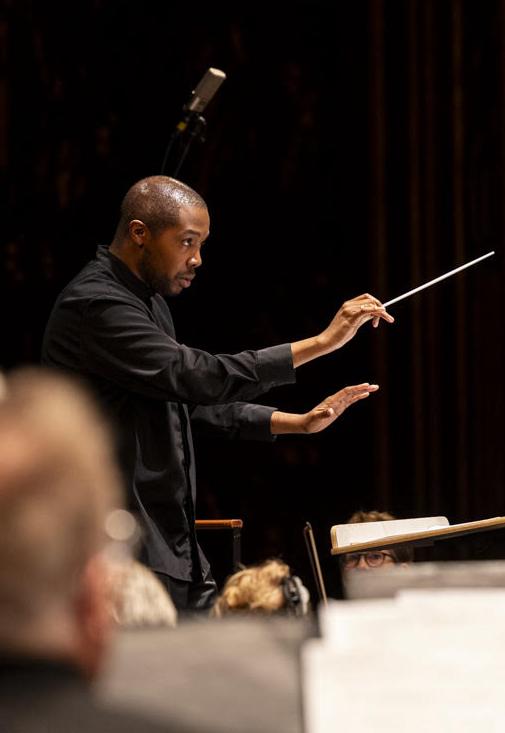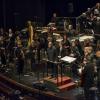
Kedrick Armstrong made a memorable subscription-series debut conducting the Oakland Symphony, its chorus, and Pacific Edge Voices in a thematically and musically intense program on Friday. The centerpiece was the world premiere of Here I Stand, an oratorio by composer Carlos Simon and librettist Dan Harder that celebrates the legacy of African American singer, actor, and activist Paul Robeson (1898–1976). Not least due to the convincing portrayal by the evening’s star soloist, bass Morris Robinson, the audience at the Paramount Theatre was able to bear witness to the tribulations Robeson suffered in his outspoken and steadfast commitment to justice and peace.
The oratorio depicts Robeson performing and internalizing identities from ballads like “Joe Hill” and spirituals such as “Go Down, Moses.” In the end, Robeson emerges as a Moses figure, and Robinson had impressively prophetic resonance to match. Ash Walker’s polished Oakland Symphony Chorus served multiple musical and dramatic identities in the oratorio. Scene to scene, the chorus morphs from audience to ego to conscience to a congressional committee to heavenly angels. The audience at the Paramount was coached before the performance to join in the last scene, a sing-along of “I Know I’ve Been Changed.” It was an emotional highlight because somewhere in the theater, a soprano was moved to improvise a joyous gospel embellishment.

The orchestral accompaniment is also dramatically functional, replete with heavenly harps and trumpets of individualism. In one moment, burbling strings represent blood coursing through the veins, and in another, they shimmer in anticipation. None of the orchestral liveliness distracts from the crisis-to-crisis flow of the story nor from the bass-baritone’s centrality. Measured dissonances function psychologically and allegorically, but this is not a score to challenge the ears, which might surprise listeners who know Robeson as a radical. The effect, however, was clear and direct, reinforcing a story that knows right from wrong. Simon’s music effectively employs brooding and jabbing brass and eloquently drops to sudden silences, leaving the singer-soloist to stark spoken words.
Robeson’s memoir is a key source for the piece, while the pivotal scene of confrontation is set to transcripts of Robeson’s contentious 1949 appearance before the U.S. House of Representatives Committee on Un-American Activities. Music and libretto combine for a wrenching emotional impact but communicate eloquently at a moral and intellectual level, too. Here I Stand fits the oratorio and opera tradition of mythologizing while portraying inner conflict, all in a taut 30 minutes. The work was the late Michael Morgan’s last commission for the Oakland Symphony. It’s been seven years in development and is conducive to, and deserving of, widespread performance.

The evening was bracketed by music of Joan Tower, a trailblazer for women in the male-dominated field of composition since the 1970s, and Dmitri Shostakovich, a target of the Stalinist oppression of the 1930s and ’40s. Not surprisingly, then, the concert had been marketed some places as “the artist as activist,” and those words are a good way to consider the strongest musical impressions of the performance.
The opener was Tower’s Fanfare for the Uncommon Woman No. 6. The piece has Tower’s usual style: a bubbling wellspring of playful ideas and surprises, inviting the listener to experience the composer’s own heightened receptiveness to whatever the music itself wants. In short, Tower’s music has the activist’s gift of resetting our minds so that we can listen closely and expectantly. To make that happen, the orchestra must play with alertness, rhythmic accuracy, and balance, and under Armstrong’s leadership, the Oakland Symphony did so brilliantly. Clarity is one of Armstrong’s strengths.
After intermission, Shostakovich’s Symphony No. 5 was no less emotionally wrenching than the oratorio. Yet again, the Oakland Symphony was in fine form. The brass, harps, and wind soloists stood out in tender moments and came together with massive power for the climaxes. The strings were assertive and resonant. This was a big performance in so many ways, not just in the notoriously shattering ending.
Armstrong carved the many sustained melodies into ear-catching shapes rather than unswerving long lines. Prominent supporting lines also added to the moment-by-moment surprises. Armstrong’s energy made a visible and audible impact as he rocked, swayed, bowed, bent, and leaned into the orchestra to accentuate the punch of Shostakovich’s rhythms. The whole of the scherzo was physically compelling. The symphony was wrenching in its anguish but also punchy and mighty. In performance and in the preconcert interview, Armstrong seemed irrepressibly involved. He is also a musical activist of the highest order and in the best sense.




